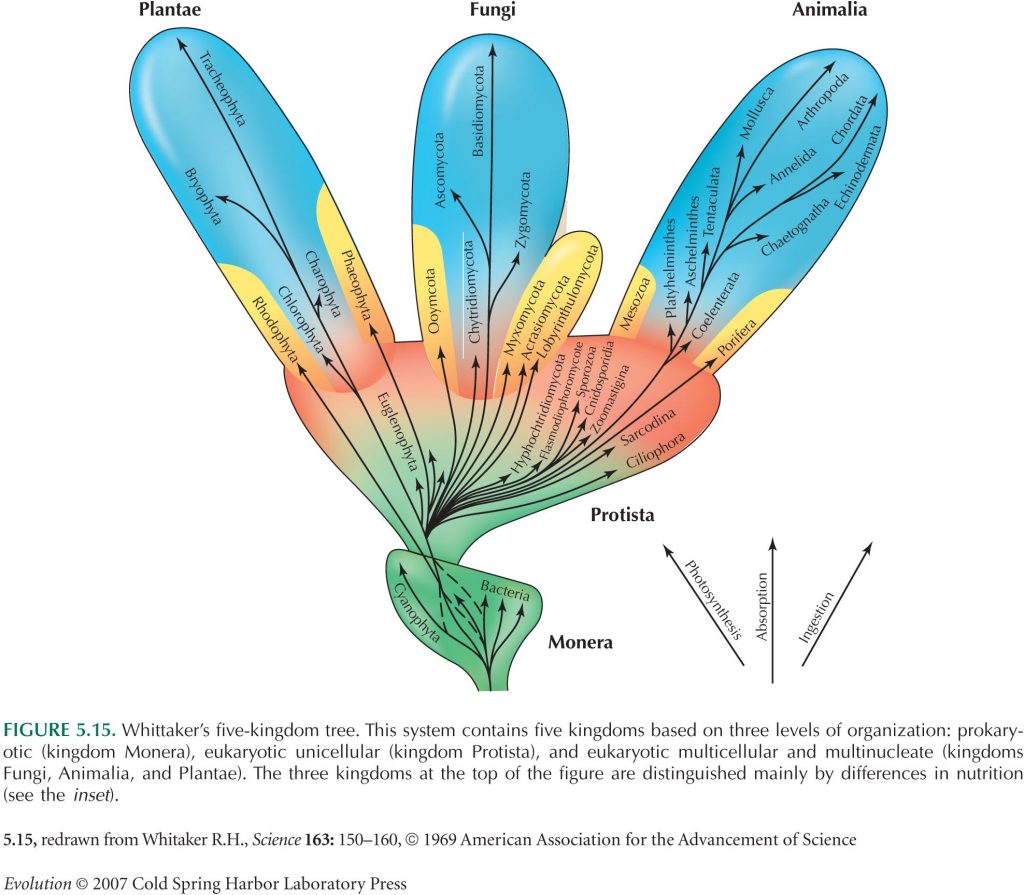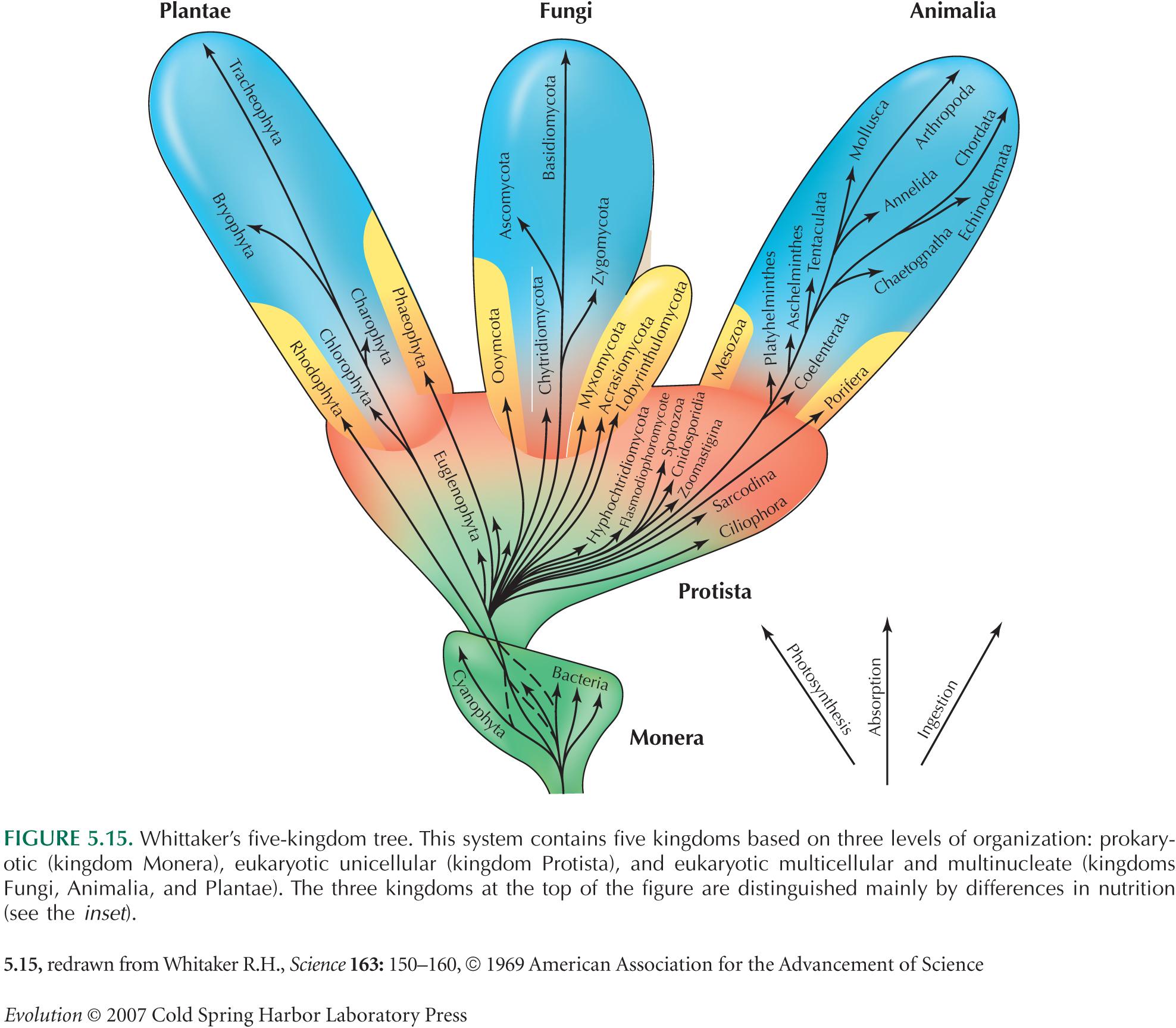In this lesson, we discussing five kingdom classification.
Five kingdom classification is proposed by R.H.Whittaker in 1969. the kingdom defined by him were named Monera, Protista, Fungi, Plantae, and Animalia.
In this lesson, we show a brief introduction to these kingdoms for more information on kingdom please visit a particular lesson on that kingdom.
Main Criteria used for this classification are cell structure, thallus organization, mode of nutrients, reproduction and phylogenetic relationship. Besides these major characteristics, he has also given importance to characters of ecological role-played and mode of reproduction.
Major criteria on which five-kingdom classification is based
| Criterion | Kingdom | ||||
| Monera | Protista | Plantae | Fungi | Animalia | |
| Cell type | Prokaryotic | Eukaryotic | Eukaryotic | Eukaryotic | Eukaryotic |
| Cellular organization | Unicellular | Unicellular | Multicellular | Multicellular | Multicellular |
| Nutrition mode | VariablePhtotrophic/ heterotrophic/ chaemoautotrophic | Phototrophic/ heterotrophic | Autotrophic (photosynthesis) | Heterotrophic (absorption) | Heterotrophic (ingestion) |
| Reproduction | Asexual | Asexual or sexual without embryo stage | Asexual or sexual with embryo stage | Asexual or sexual with spore | Sexual with embryo stage |
| Ecological role | Variable | Variable | Producer | Decomposer | Consumer |
He also attempted to establish a phylogentic relationship amongst various groups of different kingdoms.

According to him the earliest living forms (progenote) produced prokaryotic organisms or monerans. Monera gave rise to protists probably through association of several types of primitive and advanced monerans. Protists in tern gave rise to fungi, plants and animals.
The characteristic features and members of each of five kingdoms are briefly discussed:
- It is the kingdom of all the prokaryotes and includes eubacteria, cyanobacteria (bluegreen algae) and archebacteria.
- The organisms are unicellular, colonial, mycelial and filamentous in form.
- They lack true nuclei and other membrane bound organelles such as mitochondrion, chloroplast, Golgi bodies, lysosomes etc. and DNA, which is the genetic material and is called nucleoid, is not found associated with histone proteins; cell wall is often present but chemically made up material other than cellulose.
- Mode of nutrition varies from autotrophy to heterotrophy.
- Sexual reproduction is absent and asexual reproduction may take place through fission, fragmentation, budding and sporulation.
Kingdom – Protista
- It is a group of organisms differing widely with one another except that they all are simple and minute eukaryotes. It includes microalgae, protozoa and slime moulds.
- Majority of them are unicellular but some may be colonial in form.
- They contain true nuclei and membrane bound organelles; cell wall may or may not be present.
- Nutrition is very diversified and may be autotrophic (via photosynthesis) or heterotrophic (ingestion/absorption).
- Asexual means of reproduction is common but when organisms reproduce sexually, embryo is not formed.
Kingdom – Fungi
- It is the group of mostly multicellular or multinucleate achlorophyllous and sporeproducing eukaryotic organisms and includes mildews, moulds, yeasts, morals, truffles, mushrooms, rusts etc.
- The body of organisms is mycelial in form; cell wall is present and made up of chitin or cellulose.
- Nutrition is absorptive heterotrophy where organism secretes digestive enzymes into the substrate and then absorbs the digested food.4. Asexual reproduction is primary mode of reduction and sexual reproduction causes
- Asexual reproduction is primary mode of reduction and sexual reproduction causes formation of specialized spores.
- They play the ecological role of decomposer.
Kingdom – Plantae
- It includes all coloured multicellular photosynthetic eukaryotic organisms commonly called as plants. The important constituents are macroalgae, bryophytes,
pteridophytes, gymnosperms and angiosperms. - Plant body is either thalloid (algae and some of bryophytes) or differentiated into
root, stem and leaves; nonmotile; Cell wall is present and it is chemically made up of cellulose. - Nutrition by: autotrophy (photosynthetic)
- Both asexual and sexual reproductions occur. An embryo stage is present except in algal group.
- They play the ecological role of producers.
- It is a group of all macroscopic animals derived from zygote and includes sponges, coelentrates, worms, annelids, arthopodes, mollusces, star fishes, fishes, amphibians, reptiles, birds and mammals.
- Organisms are multicellular with higher degree of body organization where tissue differentiation usually leads to specialized organ formation. Eukaryotic cell is without cell wall and chlorophyll pigments.
- They exhibit mobility, sensitivity to different stimuli and definite growth.
- They reproduce primarily by sexual reproduction and embryo stage is usually present.
- They play ecological role of consumer.





Leave a Reply
You must be logged in to post a comment.